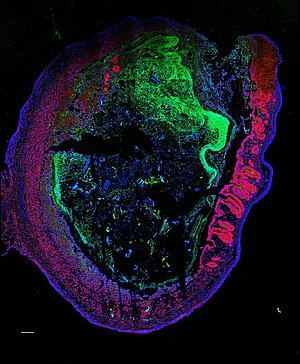The boundary keepers: Structure, activity, and genomic potential of intestinal mucus-associated microbial communities
 The healthy human and animal intestine harbors a tremendous number and diversity of symbiotic microorganisms separated only by a secreted layer of mucus. The mucus layer is essential for mediating immunological tolerance and protecting against pathogen invasion. The secreted mucus is not only a critical physical boundary for the host but also a unique niche for microorganisms, and acts both as a physical habitat as well as a nutrient source. While we know that the microbiota associated with mucus is distinct from the overall lumen microbiota, we know very little about the composition and spatial structuring of the mucus-associated community in the different intestinal compartments. Due to the complexity of the intestinal ecosystem we have been unable to directly study mucus compound foraging and therefore almost everything we know is based on simplified model systems. This project aims to fill this knowledge gap by shedding light on the composition, structure, ecophysiology, and metabolic flexibility of mucus-associated microbiota in the mouse intestine using a combination of complementary approaches that rely primarily on cultivation-independent and single-cell techniques and showcase a novel in vivo isotope labeling approach. First, the composition and spatial structure of the mucus-associated intestinal microbiota in mice will be elucidated using sequencing techniques and fluorescence in situ hybridization combined with quantitative image analysis. Then, using our recently developed in vivo isotope labeling approach to study host-compound utilizers, we will identify microbial populations utilizing key glycan sugars and amino acids derived from secreted host compounds. This will allow us to distinguish for the first time between host-compound foragers and microorganisms only physically-associated with the mucus. In order to establish to what degree foragers are dependent on host-compounds, colonization experiments in mucus-deficient mice will be performed. Dietary polysaccharide content and type will be modulated in order to determine if host-compound foragers are stimulated by diets rich in compounds with structural similarities to secreted mucin. Finally, a comparative genomic analysis will identify conserved genomic features of key host-compound foragers, which will support our basic understanding of the ecophysiology of members of this important intestinal guild. Together, application of these cutting-edge approaches will provide tools and a valuable conceptual foundation of the structure and activity of the mucus-associated microbiota for future studies of these important intestinal “boundary keepers”.
The healthy human and animal intestine harbors a tremendous number and diversity of symbiotic microorganisms separated only by a secreted layer of mucus. The mucus layer is essential for mediating immunological tolerance and protecting against pathogen invasion. The secreted mucus is not only a critical physical boundary for the host but also a unique niche for microorganisms, and acts both as a physical habitat as well as a nutrient source. While we know that the microbiota associated with mucus is distinct from the overall lumen microbiota, we know very little about the composition and spatial structuring of the mucus-associated community in the different intestinal compartments. Due to the complexity of the intestinal ecosystem we have been unable to directly study mucus compound foraging and therefore almost everything we know is based on simplified model systems. This project aims to fill this knowledge gap by shedding light on the composition, structure, ecophysiology, and metabolic flexibility of mucus-associated microbiota in the mouse intestine using a combination of complementary approaches that rely primarily on cultivation-independent and single-cell techniques and showcase a novel in vivo isotope labeling approach. First, the composition and spatial structure of the mucus-associated intestinal microbiota in mice will be elucidated using sequencing techniques and fluorescence in situ hybridization combined with quantitative image analysis. Then, using our recently developed in vivo isotope labeling approach to study host-compound utilizers, we will identify microbial populations utilizing key glycan sugars and amino acids derived from secreted host compounds. This will allow us to distinguish for the first time between host-compound foragers and microorganisms only physically-associated with the mucus. In order to establish to what degree foragers are dependent on host-compounds, colonization experiments in mucus-deficient mice will be performed. Dietary polysaccharide content and type will be modulated in order to determine if host-compound foragers are stimulated by diets rich in compounds with structural similarities to secreted mucin. Finally, a comparative genomic analysis will identify conserved genomic features of key host-compound foragers, which will support our basic understanding of the ecophysiology of members of this important intestinal guild. Together, application of these cutting-edge approaches will provide tools and a valuable conceptual foundation of the structure and activity of the mucus-associated microbiota for future studies of these important intestinal “boundary keepers”.
This project is funded by the Austrian Science Foundation. The project runtime is 1.11.2013 to 31.10.2016.





